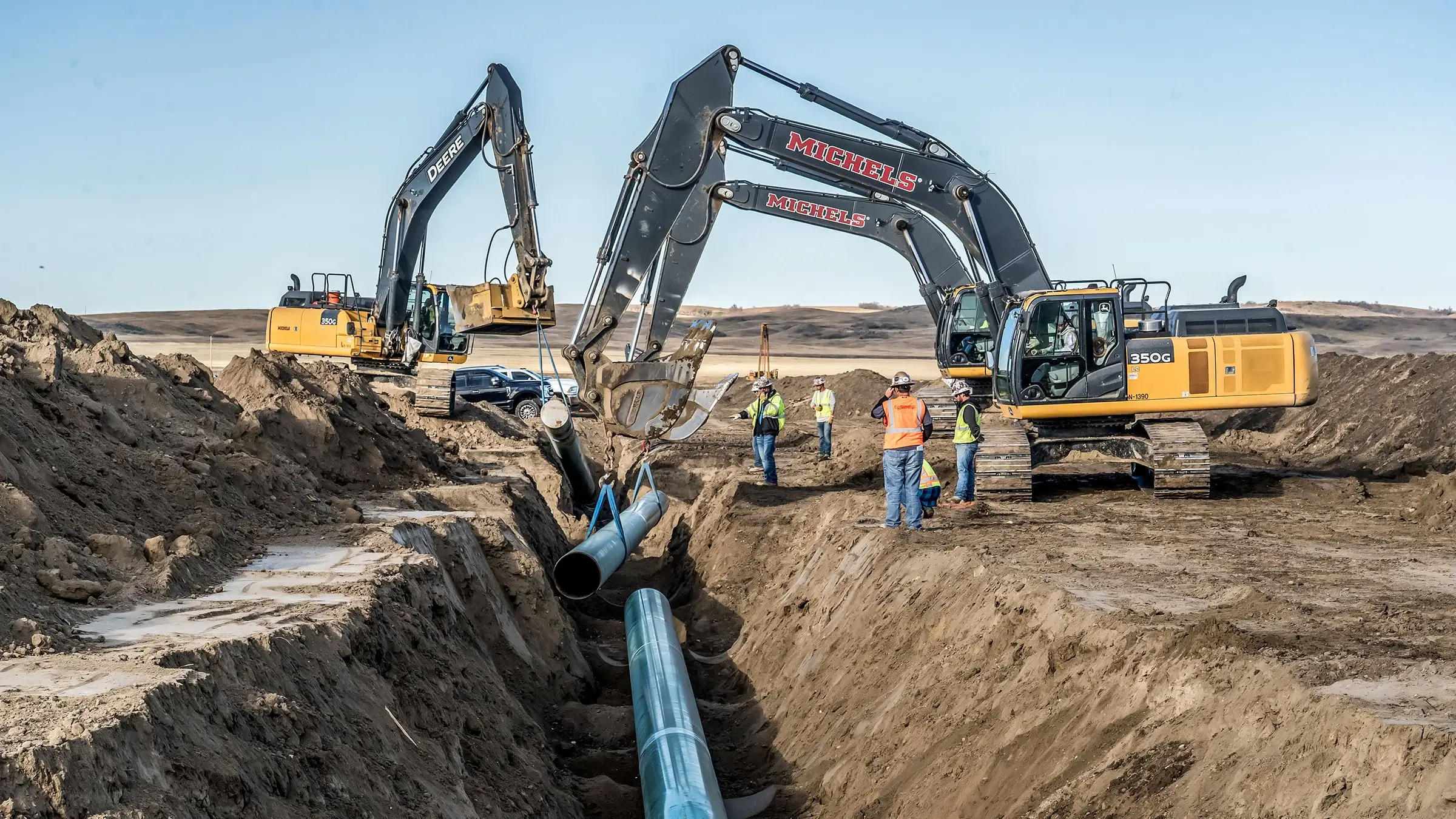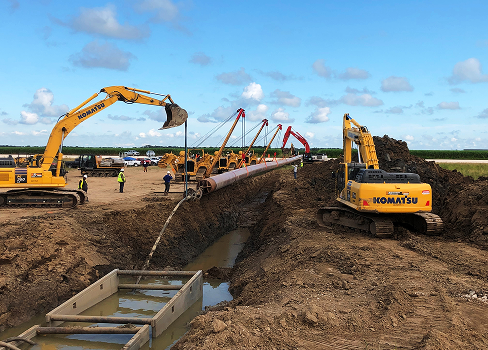Checking Out the most up to date Advancements in Pipeline Construction Solutions for Modern Projects
The Pipeline Construction industry is undergoing substantial adjustments. Advancements such as clever materials and robotics are reshaping traditional practices. These innovations assure to boost effectiveness and safety and security. In addition, AI modern technologies are boosting job monitoring capacities. As these aspects assemble, they increase questions regarding their long-lasting effect on sustainability and price. Comprehending these advancements is important for stakeholders looking to browse this developing landscape. What implications do they hold for future tasks?
The Increase of Smart Products in Pipeline Construction
As the need for more lasting and effective Pipeline systems increases, the assimilation of wise products has actually emerged as a transformative remedy in Pipeline Construction. These advanced products possess distinct residential or commercial properties that boost the performance and long life of pipelines. As an example, self-healing polymers can automatically fix minor leakages, considerably reducing upkeep expenses and downtime. Additionally, materials installed with sensors can keep an eye on architectural integrity and environmental problems, enabling real-time data collection and evaluation.
In addition, smart materials are often lightweight and corrosion-resistant, which not just simplifies setup yet additionally extends the life expectancy of the systems. Their adaptability makes it possible for pipelines to hold up against severe environmental problems, promoting safety and security and reliability. As markets increasingly prioritize sustainability, using green clever products adds to minimized ecological effect. In general, the increase of clever materials marks a noteworthy shift in Pipeline Construction, paving the way for innovative solutions to meet modern framework demands.
Innovations in Robotics for Installment and Upkeep
The combination of smart materials in Pipeline Construction is enhanced by innovations in robotics, which are reinventing setup and maintenance procedures. Robot innovations, such as automated welding systems and drones, enhance efficiency and accuracy, minimizing human error and minimizing safety and security dangers. These robots can run in tough settings, making sure that installations are conducted in remote or unsafe locations without placing workers at risk.
Robot evaluation devices geared up with advanced sensing units supply real-time data on Pipeline stability, allowing for proactive maintenance. They can detect leakages or structural weak points, making it possible for timely treatments that expand the lifespan of Pipeline systems. The usage of robotics not just increases the Construction timeline however additionally maximizes resource appropriation, resulting in set you back savings. As these innovations proceed to develop, they are established to play a vital duty in shaping the future of Pipeline Construction, making certain reliability and sustainability in facilities growth.
AI-Driven Project Administration Devices Changing Workflow
AI-driven job administration devices are reshaping workflows in Pipeline Construction by improving decision-making procedures via improved access to real-time data analytics. These devices make it possible for groups to respond quickly to job growths, thereby enhancing effectiveness. Structured communication channels foster partnership among stakeholders, better optimizing project outcomes.
Enhanced Decision-Making Procedures

Real-Time Data Analytics
Utilizing real-time data analytics, modern project monitoring devices change process in Pipeline Construction. These innovative tools utilize expert system to give immediate understandings right into task performance, resource allowance, and potential dangers. By continually monitoring vital performance indications, groups can promptly adapt to transforming problems, optimizing labor and products usage. The integration of real-time data permits for more informed decision-making, minimizing hold-ups and decreasing prices. Furthermore, anticipating analytics can determine patterns and projection difficulties prior to they escalate, improving general project effectiveness. Consequently, Pipeline Construction companies that adopt these AI-driven tools can enhance project timelines and outcomes, guaranteeing they remain competitive in an increasingly complex industry landscape. This development notes a substantial shift towards data-centric monitoring techniques.
Structured Communication Channels
Efficient interaction is paramount in Pipeline Construction, where numerous stakeholders need to collaborate effortlessly to ensure job success. The introduction of AI-driven task administration devices has actually changed communication networks within the industry. These tools assist in real-time details sharing, allowing teams to gain access to updates, share files, and track progression effectively. By automating regular tasks and giving a centralized system for interaction, these advancements eliminate misconceptions and lower delays. Boosted visibility right into project timelines and source allocation promotes liability amongst team members. In addition, AI analytics can identify potential interaction voids, guaranteeing aggressive problem-solving. Inevitably, streamlined communication networks not just enhance workflow but additionally raise total job efficiency, making it possible for Pipeline Construction firms to fulfill contemporary demands effectively.
Improved Safety And Security Protocols With Modern Technology Integration
The combination of innovation in Pipeline Construction has actually brought about enhanced safety protocols. Real-time monitoring systems, wearable safety gadgets, and automated danger evaluations are currently essential components in lessening threats on job sites. These developments not only enhance worker security but also streamline conformity with sector guidelines.
Real-Time Tracking Solutions
How can real-time monitoring systems transform Pipeline Construction safety and security methods? By incorporating sophisticated innovation, these systems supply constant security of Construction activities, guaranteeing immediate discovery of prospective dangers. Video cameras and sensors can check ecological conditions, equipment efficiency, and workforce movements, delivering critical information in actual time. This positive method allows task managers to recognize threats prior webpage to they escalate, considerably boosting precaution on-site. Additionally, real-time monitoring facilitates conformity with governing requirements, ensuring that safety criteria are fulfilled consistently. The capacity to examine data immediately supports enlightened decision-making, allowing timely interventions. As a result, Pipeline Construction tasks can run much more successfully while securing the well-being of employees and lessening accidents, thus revolutionizing the market's safety and security landscape.
Wearable Safety Tools
Regularly, wearable safety gadgets are being incorporated into Pipeline Construction to improve safety and security procedures. These cutting-edge tools, consisting of smart safety helmets, vests, and wristbands, are designed to check worker health and wellness and environmental problems in real-time. Equipped with sensors, these devices can identify hazards such as harmful gas exposure, extreme warmth, or high sound degrees, providing immediate notifies to employees and managers. Additionally, wearable innovation usually consists of GPS monitoring attributes, allowing for effective area surveillance of employees on-site. This capacity not just help in fast feedback throughout emergency situations yet additionally enhances overall project management. By prioritizing worker security via innovation assimilation, Pipeline Construction firms are making significant strides in lowering accidents and advertising a society of security within the sector.

Automated Threat Assessments
While standard threat evaluations often count on hands-on assessments, the integration of computerized danger analysis technologies is changing safety methods in Pipeline Construction. These sophisticated systems utilize information analytics, expert system, and artificial intelligence to recognize potential risks a lot more accurately and successfully. By constantly keeping an eye on ecological conditions, tools standing, and employee actions, automated assessments provide real-time insights that enhance decision-making. This proactive strategy reduces the possibility of mishaps and improves conformity with safety regulations. In addition, automated risk assessments can be updated instantly, making sure that all stakeholders have access to the most recent info. Because of this, Pipeline Construction projects gain from a more secure workplace, lessening interruptions and promoting a culture of safety and security via innovation combination.
Sustainable Practices in Pipeline Construction
As the demand for power facilities rises, the Pipeline Construction industry progressively prioritizes lasting practices that decrease ecological impact. Firms are embracing environmentally friendly materials and innovative Construction methods to reduce their carbon impact. For example, using trenchless modern technology permits Pipeline installation with very little disruption to the surrounding setting, protecting natural habitats and reducing soil erosion.
Additionally, the application of renewable resource resources, such as solar or wind, to power Construction activities is obtaining traction. This change not just reduces reliance on fossil gas yet additionally enhances the total sustainability of Pipeline jobs. Moreover, efficient waste monitoring techniques, including recycling and reusing products, are coming to be criterion in the sector.
Real-Time Tracking and Predictive Maintenance Solutions
The shift towards lasting techniques in Pipeline Construction has actually led the way for the combination of real-time tracking and predictive maintenance solutions. These technologies leverage progressed sensing units and information analytics to continuously assess Pipeline integrity and functional effectiveness. By gathering data in real time, operators can spot anomalies such as leakages or stress decreases prior to they intensify into significant problems. This proactive approach not just lessens environmental dangers but also lowers downtime and upkeep expenses.
Predictive maintenance uses algorithms to anticipate prospective failures based upon historical information and present performance metrics. This makes it possible for prompt interventions, optimizing upkeep routines and source allowance. On the whole, real-time surveillance and predictive upkeep services stand for a considerable development in Pipeline Construction, boosting security and reliability while sustaining sustainability goals. As sectors remain to embrace these technologies, the functional landscape of Pipeline management is established to develop significantly, ensuring long-lasting viability and performance.
The Duty of Drones in Checking and Examination
Drones have actually emerged as transformative devices in the checking and examination of pipes, offering boosted efficiency and accuracy. Their capability to catch high-resolution images and videos from various angles enables comprehensive analyses of Pipeline stability without risking human security. Equipped with sophisticated sensors and thermal imaging capabilities, drones can detect leakages, deterioration, and architectural anomalies that may not be noticeable to the nude eye.
The deployment of drones significantly minimizes assessment time, making it possible for quicker decision-making for upkeep and repairs. This efficiency converts to set you back financial savings and marginal disruption to surrounding settings. Drones can additionally access hard-to-reach areas, such as elevated structures or sturdy terrains, further increasing the range of evaluations.
As the Pipeline sector remains to welcome technological improvements, the assimilation of drones into surveying and evaluation processes is expected to expand, setting new criteria for functional excellence and security in Pipeline Construction solutions.
Regularly Asked Inquiries
What Are the Costs Connected With Modern Pipeline Construction Innovations?
The expenses connected with modern-day Pipeline Construction advancements usually include innovative materials, specialized labor, and innovative innovation. These aspects add to higher initial financial investment, however can lead to long-lasting savings through enhanced effectiveness and reduced maintenance requirements.
Just How Do Governing Changes Impact Pipeline Construction Technologies?
Regulative adjustments considerably influence helpful site Pipeline Construction innovations by requiring the adoption of much safer, a lot more efficient methods. Compliance requirements often drive development, bring about developments in products, style, and Construction strategies that improve overall task sustainability and safety and security.
What Skills Are Needed for Professions in Advanced Pipeline Construction?

Careers in innovative internet Pipeline Construction need knowledge in engineering principles, job management, security protocols, and environmental regulations. Furthermore, skills in technology combination, synergy, and analytical are vital for traversing the complexities of contemporary infrastructure projects.
Exactly How Can Business Make Certain Conformity With Environmental Standards?
To ensure conformity with environmental requirements, business must carry out strenuous training programs, carry out normal audits, and adopt best practices in sustainability. Engaging with stakeholders and keeping track of regulative changes additionally strengthens their dedication to environmental stewardship.

What Are the Key Difficulties Dealing With Pipeline Construction Today?
The crucial difficulties facing Pipeline Construction today include governing compliance, ecological issues, varying material costs, labor scarcities, and the need for advanced modern technology assimilation (Pipeline Construction Services). These factors complicate task timelines and general performance in the sector
As the need for much more lasting and efficient Pipeline systems enhances, the combination of smart products has arised as a transformative service in Pipeline Construction. AI-driven task management tools are improving process in Pipeline Construction by boosting decision-making processes through improved access to real-time information analytics. While task administration in Pipeline Construction has actually commonly relied on hands-on processes, the combination of advanced devices substantially improves decision-making capabilities. Using real-time information analytics, modern-day task management tools reinvent workflow in Pipeline Construction. Jobs in sophisticated Pipeline Construction need expertise in design concepts, project administration, safety and security procedures, and environmental regulations.